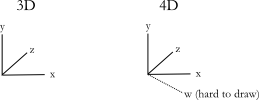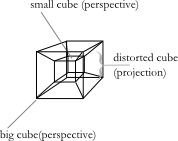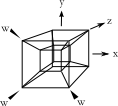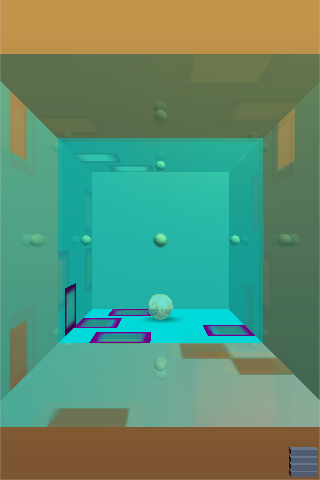A brief explanation
In our three dimensional world we think of three coordinates x,y,z. A fourth dimensions can be obtained by simply adding a coordinate. So if in 3D we have coordinates named x,y,z then in 4D we might have w,x,y,z

Projection
When we project a higher dimension object on to a lower dimension, we get distortion. A cube consist of 6 square faces. But drawing that three dimensional cube on to a 2D surface might look like this.

Only two of the squares that make up the cube are still square, the other four are now distorted.
A cube is made
Just as a cube can be thought of as a plane copied into the third dimension.

So too a tesseract is cube moved perpendicular into 4D along that w coordinate.

But that picture is almost unintelligible so a little more explanation is needed.
Perspective
When we represent 3D objects, we think of them in perspective. While it is possible to present the 3D world without perspective such as in an isometric projection, there are several difficulties. In our case, the main problem would be that foreground objects are the same size as background objects and if we were looking at a transparent cube there would be no way to tell which face is in front. The pictures above have no perspective and so we can not tell which face is in front of the other. With perspective a cube looks like this:

So when we project our 4D object onto 3D we are going to have to apply perspective or the image will be even harder to understand and some of the cubes that make it up will completely over lap and not be shown at all. For example a cube drawn face on with perspective vs without

All together
So we represent a 4D object by applying perspective then projecting it into 3D which causes distortion (and obviously this 3D object is then reduced to 2D on the screen) On a cube, perspective makes some squares smaller than others. On a tesseract, perspective will make some
cubes smaller than others. On a cube the distortion will make some squares not square shaped. On a tesseract it makes some cubes not cube shaped. So we get this:

we can now indicate the w,x,y,z axises although the w axis is still hard to indicate as it is the axis of perspective on which items shrink and grow.

Rotation
We normally think of rotation occurring about an axis. In 3D we think of thee possible axis of rotation

As it turns out, this is misleading: the idea of an axis of rotation only works in 3D. But it is obvious that a rotation in 2D has no axis. Indeed looking at 2D we notice one obvious feature, the rotation is on a plane.

And moving up to 4D, the idea of an axis of rotation is nonsense but the idea of rotation on planes is still valid.
So we should think of 3D rotations as rotations on three possible planes xy, xz, yz
If in 3D we have coordinates named x,y,z then in 4D we would have w,x,y,z. What planes of rotation become possible in this case? It turns out we get three more: rotations on the wx, wy, and wz planes. Picturing this on our model we get

Rotating along this axis will create a sort of inside out movement as the inner cube changes places with the outer cube moving through the distorted shape in between.
The game
The game plays with all this by adding an unusual kind of gravity. A ball can be moved from one cell to another but when done in an interesting order, it ends up on ceilings and walls. The player needs to get a sense of that ordering to win.














